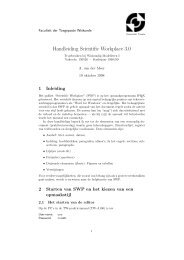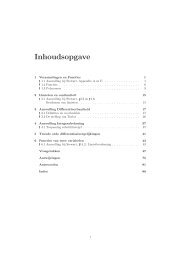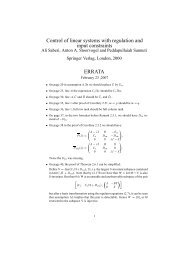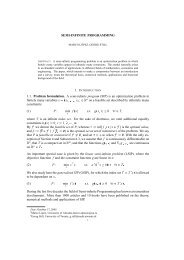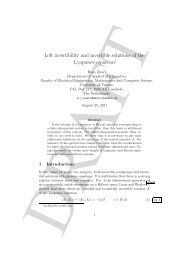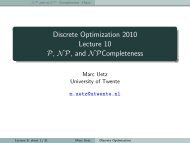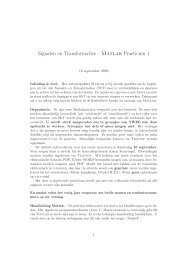Dispersion and dissipation error in high-order Runge-Kutta ...
Dispersion and dissipation error in high-order Runge-Kutta ...
Dispersion and dissipation error in high-order Runge-Kutta ...
Create successful ePaper yourself
Turn your PDF publications into a flip-book with our unique Google optimized e-Paper software.
time-doma<strong>in</strong> Maxwell equations numerically. This popularity is ma<strong>in</strong>ly due to their simplicity<br />
<strong>and</strong> efficiency <strong>in</strong> discretis<strong>in</strong>g simple-doma<strong>in</strong> problems. However, their <strong>in</strong>ability to<br />
effectively h<strong>and</strong>le complex geometries prompted some scientists to search for alternatives<br />
long ago. F<strong>in</strong>ite-element (FE) methods are an obvious alternative, but early efforts were<br />
marred by the fact that st<strong>and</strong>ard cont<strong>in</strong>uous Galerk<strong>in</strong> f<strong>in</strong>ite-element schemes give rise to<br />
non-physical solutions. Most apparent of these are the spurious modes <strong>in</strong> the numerical<br />
solution of the frequency-doma<strong>in</strong> Maxwell equations (see [24] <strong>and</strong> references there<strong>in</strong>).<br />
The revolutionary solution to this problem was to realise that by us<strong>in</strong>g a particular set<br />
of vector basis functions (vector elements such as Nédélec or Whitney elements [20, 29]),<br />
it is possible to mimic many of the special properties of the Maxwell equations at the<br />
discrete level. See [3] <strong>and</strong> [4]. Ever s<strong>in</strong>ce, vector elements have been a viable alternative<br />
to FDTD <strong>and</strong> st<strong>and</strong>ard FE methods <strong>in</strong> computational electrodynamics, especially<br />
for frequency-doma<strong>in</strong> problems with complex geometries. The practical considerations of<br />
both st<strong>and</strong>ard <strong>and</strong> vector f<strong>in</strong>ite elements <strong>in</strong> computational electromagnetics are covered<br />
<strong>in</strong> [24]. For the more theoretical aspects of Nédélec elements we refer to [27].<br />
The need to model electromagnetic wave propagation <strong>in</strong> large <strong>and</strong> complex doma<strong>in</strong>s<br />
<strong>and</strong> over a relatively long time span has <strong>in</strong>creased the dem<strong>and</strong> for <strong>high</strong>-<strong>order</strong> methods.<br />
However, neither <strong>high</strong>-<strong>order</strong> FDTD methods nor <strong>high</strong>-<strong>order</strong> vector FE methods are devoid<br />
of practical drawbacks. High-<strong>order</strong> FDTD methods fail to effectively h<strong>and</strong>le complex<br />
geometries whereas <strong>high</strong>-<strong>order</strong> vector FE methods (based on <strong>high</strong>-<strong>order</strong> Nédélec elements<br />
[29] for example) lead to global mass matrices with relatively large b<strong>and</strong>widths (after<br />
optimal re<strong>order</strong><strong>in</strong>g). The time-<strong>in</strong>tegration schemes to solve such systems are <strong>in</strong> turn<br />
computationally rather expensive. These difficulties have motivated the development<br />
of discont<strong>in</strong>uous Galerk<strong>in</strong> (DG) f<strong>in</strong>ite-element methods [9, 11], together with spectral<br />
element methods [25]. In both the frequency-doma<strong>in</strong> formulation [19, 21, 30, 31, 35]<br />
<strong>and</strong> the time-doma<strong>in</strong> formulation [6, 10, 18, 28] significant progress has been made. One<br />
of the most promis<strong>in</strong>g methods for complicated geometries is the <strong>high</strong>-<strong>order</strong> nodal DG<br />
method of Hesthaven <strong>and</strong> Warburton [18], which proved both accurate <strong>and</strong> efficient for the<br />
spatial discretisation. In time <strong>in</strong>tegration, however, the low-storage <strong>Runge</strong>-<strong>Kutta</strong> (RK)<br />
method the authors applied poses a comparatively str<strong>in</strong>gent time-step constra<strong>in</strong>t, which<br />
may turn out to be the bottleneck for long-time <strong>in</strong>tegration. Furthermore, fixed-<strong>order</strong><br />
time-<strong>in</strong>tegration schemes may spoil the <strong>high</strong>-<strong>order</strong> convergence of the global scheme. In<br />
the meantime, for discont<strong>in</strong>uous formulations of convection-dom<strong>in</strong>ated problems [11] it<br />
has been shown <strong>in</strong> [14] <strong>and</strong> <strong>in</strong> [6] that the time-step restriction may be loosened if we use<br />
Strong-Stability-Preserv<strong>in</strong>g <strong>Runge</strong>-<strong>Kutta</strong> (SSP-RK) methods of one <strong>order</strong> <strong>high</strong>er than the<br />
polynomial <strong>order</strong> of the spatial discretisation.<br />
In this work, we study the behaviour of the <strong>high</strong>-<strong>order</strong> nodal scheme when several of<br />
the best-suited time-<strong>in</strong>tegration methods are used. In particular, we have a closer look<br />
at the dispersion <strong>and</strong> <strong>dissipation</strong> properties of the <strong>Runge</strong>-<strong>Kutta</strong> discont<strong>in</strong>uous Galerk<strong>in</strong><br />
(RKDG) method compris<strong>in</strong>g the nodal <strong>high</strong>-<strong>order</strong> DG method <strong>and</strong> the SSP-RK method.<br />
The ma<strong>in</strong> motivation for us<strong>in</strong>g this particular time-<strong>in</strong>tegration scheme is its relatively<br />
weak time-step restriction. This property implies that we can reta<strong>in</strong> <strong>high</strong>-<strong>order</strong> accuracy<br />
without los<strong>in</strong>g much on the computational work measured as the number of operations.<br />
The literature on the dispersion <strong>and</strong> <strong>dissipation</strong> properties of the DG method has <strong>in</strong><br />
recent years become abundant. A thorough analysis of the dispersion <strong>and</strong> <strong>dissipation</strong><br />
2



